
Insulin: What school staff need to know
Glucose is an essential source of energy for our bodies. Although our bodies make glucose, most of what we need comes from the food we eat (for more information, see Food and type 1 diabetes).
Insulin is a hormone produced by the pancreas that controls the level of glucose in the blood. Insulin helps the glucose get into the cells so it can be used for energy. The pancreas is a very complex organ that constantly adjusts insulin levels, minute to minute, to keep the blood glucose in a healthy range.
The amount of glucose in the body at a specific point in time is called “blood sugar” or “blood glucose” (abbreviated as BG) level. This graph shows how blood glucose fluctuates normally, in a person without diabetes:

Note
Without insulin, glucose builds up in the blood, causing tiredness, thirst, frequent urination, and weight loss. These are some of the symptoms of untreated type 1 diabetes.
Insulin and type 1 diabetes
People with type 1 diabetes do not produce any insulin, so it must be replaced. It is very difficult to do what the pancreas does (in the graph above), adjusting to food intake, activity levels, stress, and other factors. Insulin injections or an insulin pump are effective, but neither can respond the same way a pancreas can.
The ideal situation is to give insulin before every meal, varying the amount according to how much a person is planning to eat and how high their blood sugar is. So for example, if they are eating a small amount of food, the insulin dose will be small. If they are eating a big meal, they will need more insulin. The formula to determine the insulin dose is specific to each person.
This kind of intensive management results in better overall diabetes control and helps to prevent or delay long-term complications of diabetes. For children and youth in school, it means they would need insulin at lunch every day, and this isn’t always an option.
Another way to manage diabetes is to give a slower-acting insulin at breakfast, which will be active around lunchtime and in the afternoon. This is less precise dosing but is the best alternative if giving insulin at lunch is not an option. Students on this regimen will take insulin 2 to 3 times a day: breakfast, dinner (suppertime), and usually at bedtime.
How children receive their insulin is an individual decision that parents make with their child’s health professional. Details will be in a student’s Individual Care Plan.
How insulin is delivered
Insulin is delivered in one of three ways:
- Syringe: Insulin is drawn from a vial into the syringe, and injected under the skin— in an arm, thigh, buttocks or stomach.
- Insulin pen: More convenient and discreet than a syringe, a pen uses a cartridge of insulin and a dial that allows the user to select the dose. There is a fine needle at the tip of the pen.
- Insulin pump: A device that administers insulin continuously through a small tube inserted under the skin. The user directs the pump to give a bolus (dose) of extra insulin with meals or to correct high blood sugar levels. A pump is not an artificial pancreas: It requires a user to determine when and how much insulin to give.




How insulin is stored
- Unopened vials or cartridges or insulin are refrigerated until they are ready to use. Be sure that insulin does not freeze.
- Once opened, most vials and cartridges can be left at room temperature for no more than 30 days.
- Always check expiration dates before using. Do not use insulin that has expired.
How much insulin to give
If a student needs insulin during the school day, details will be in their Individual Care Plan. School staff who are designated to administer or help with insulin will be trained on how to determine the dose as well as how to give it. Here are the basic steps:
Remember
The amount of insulin a person needs depends on how much food they eat, their activity levels, their age and size, and other factors. Insulin doses may vary from day to day.
Insulin via a pump
- Check blood sugar (BG) before the student eats. The reading will:
- Be sent to the pump by the meter, or
- Need to be manually entered into the pump.
- Enter the total number of carbohydrates to be eaten (as labeled by parent or the student)
- The pump will calculate the amount of insulin to be given. Press the appropriate button to accept and deliver the bolus (dose).
Insulin via injection (pen or syringe)
Refer to the student’s Individual Care Plan for details. In general, parents will send food that is clearly labeled with the amount of carbohydrates, and an appropriate tool to help designated staff select the appropriate dose based on the student’s BG. A second adult should double-check the dose before delivering it.
After insulin is given at school, the dose and time should be recorded in the student’s log book or other home−school communication method.
Additional resources
- Video - Insulin: What School Staff Need To Know
- A Guide to Insulin Pumps at School
- Bolus insulin calculator for school lunches: To access this handy tool developed by B.C. Children's Hospital, click on "Basal-Bolus Insulin with MDI", then choose from among a number of links that will automatically calculate insulin dose for specific situations.
- Injection techniques: The basics
Source : Diabetes@school. diabetesatschool.ca © Canadian Paediatric Society
Last updated: